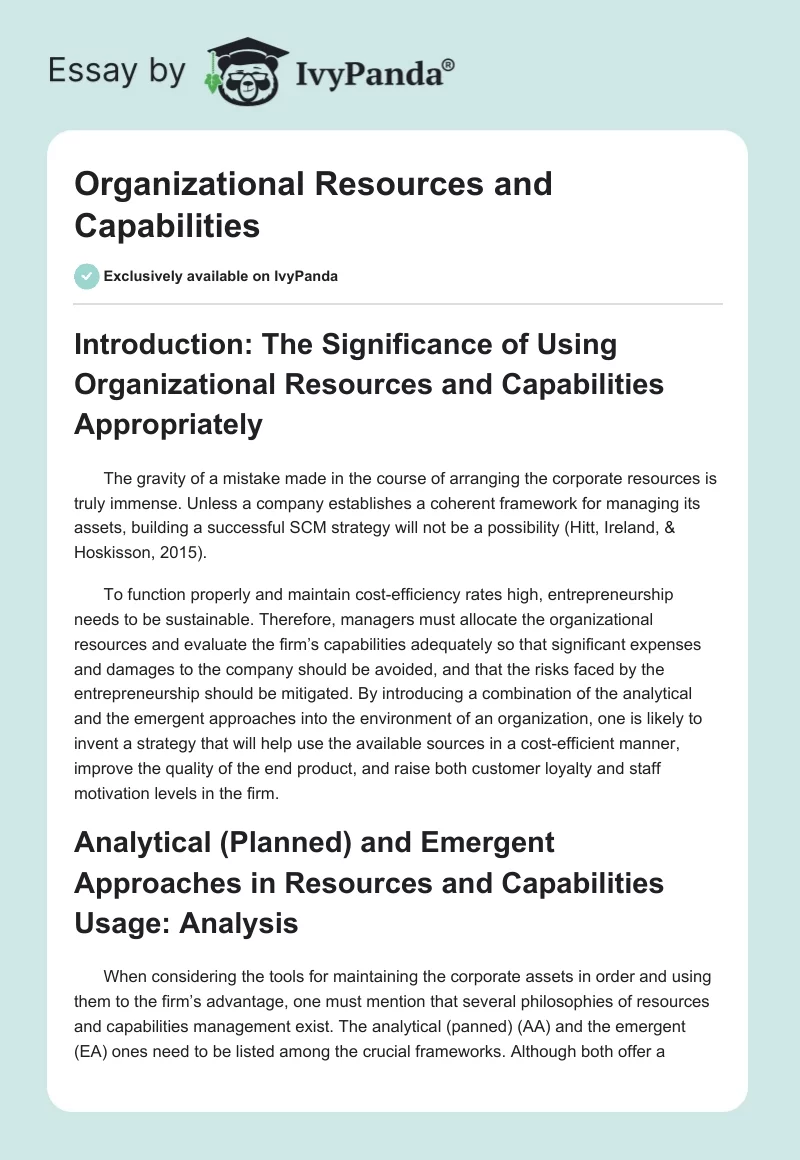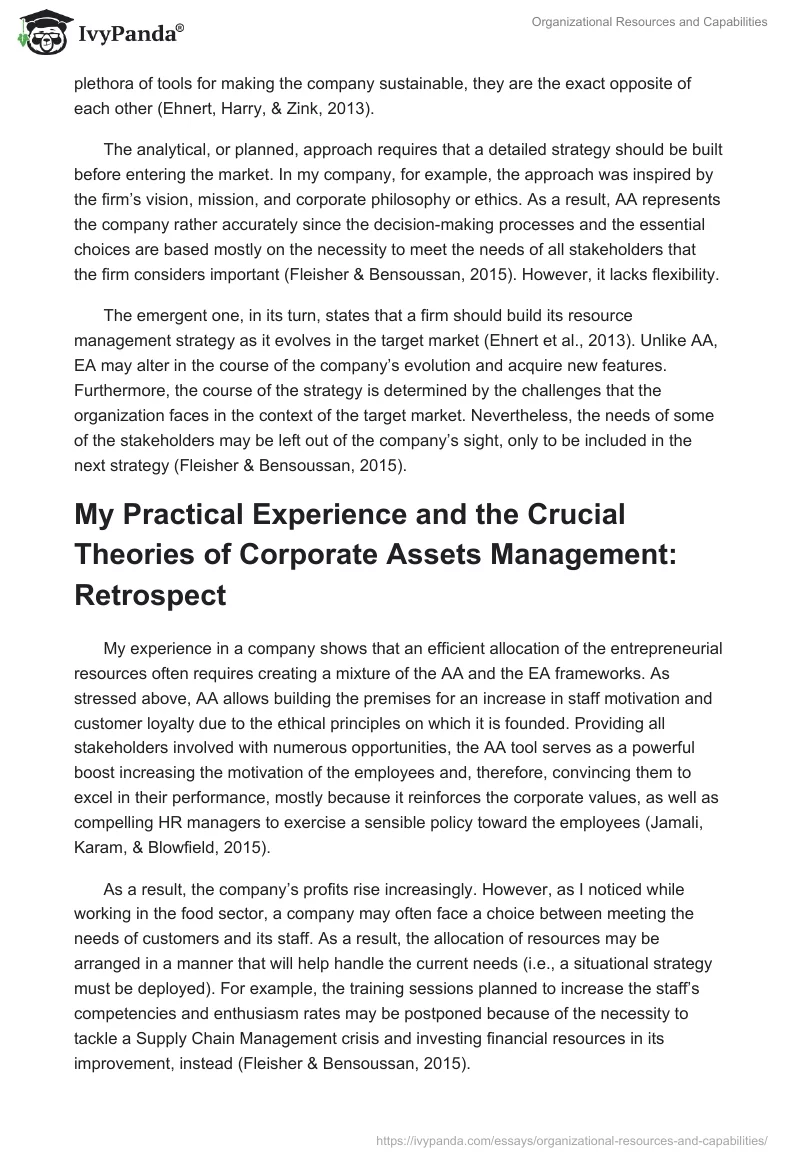Introduction: The Significance of Using Organizational Resources and Capabilities Appropriately
The gravity of a mistake made in the course of arranging the corporate resources is truly immense. Unless a company establishes a coherent framework for managing its assets, building a successful SCM strategy will not be a possibility (Hitt, Ireland, & Hoskisson, 2015).
To function properly and maintain cost-efficiency rates high, entrepreneurship needs to be sustainable. Therefore, managers must allocate the organizational resources and evaluate the firm’s capabilities adequately so that significant expenses and damages to the company should be avoided, and that the risks faced by the entrepreneurship should be mitigated. By introducing a combination of the analytical and the emergent approaches into the environment of an organization, one is likely to invent a strategy that will help use the available sources in a cost-efficient manner, improve the quality of the end product, and raise both customer loyalty and staff motivation levels in the firm.
Analytical (Planned) and Emergent Approaches in Resources and Capabilities Usage: Analysis
When considering the tools for maintaining the corporate assets in order and using them to the firm’s advantage, one must mention that several philosophies of resources and capabilities management exist. The analytical (panned) (AA) and the emergent (EA) ones need to be listed among the crucial frameworks. Although both offer a plethora of tools for making the company sustainable, they are the exact opposite of each other (Ehnert, Harry, & Zink, 2013).
The analytical, or planned, approach requires that a detailed strategy should be built before entering the market. In my company, for example, the approach was inspired by the firm’s vision, mission, and corporate philosophy or ethics. As a result, AA represents the company rather accurately since the decision-making processes and the essential choices are based mostly on the necessity to meet the needs of all stakeholders that the firm considers important (Fleisher & Bensoussan, 2015). However, it lacks flexibility.
The emergent one, in its turn, states that a firm should build its resource management strategy as it evolves in the target market (Ehnert et al., 2013). Unlike AA, EA may alter in the course of the company’s evolution and acquire new features. Furthermore, the course of the strategy is determined by the challenges that the organization faces in the context of the target market. Nevertheless, the needs of some of the stakeholders may be left out of the company’s sight, only to be included in the next strategy (Fleisher & Bensoussan, 2015).
My Practical Experience and the Crucial Theories of Corporate Assets Management: Retrospect
My experience in a company shows that an efficient allocation of the entrepreneurial resources often requires creating a mixture of the AA and the EA frameworks. As stressed above, AA allows building the premises for an increase in staff motivation and customer loyalty due to the ethical principles on which it is founded. Providing all stakeholders involved with numerous opportunities, the AA tool serves as a powerful boost increasing the motivation of the employees and, therefore, convincing them to excel in their performance, mostly because it reinforces the corporate values, as well as compelling HR managers to exercise a sensible policy toward the employees (Jamali, Karam, & Blowfield, 2015).
As a result, the company’s profits rise increasingly. However, as I noticed while working in the food sector, a company may often face a choice between meeting the needs of customers and its staff. As a result, the allocation of resources may be arranged in a manner that will help handle the current needs (i.e., a situational strategy must be deployed). For example, the training sessions planned to increase the staff’s competencies and enthusiasm rates may be postponed because of the necessity to tackle a Supply Chain Management crisis and investing financial resources in its improvement, instead (Fleisher & Bensoussan, 2015).
Benefits of the Approaches as the Tools for Managing a Firm, Legitimizing My Actions, and Gaining Support from Different Stakeholders
Company Management
As shown in the example above, the EA framework serves as the means of promoting sustainability in the corporate environment. It helps navigate the target market without suffering significant damages as it offers the philosophy for mitigating and managing risks successfully. The AA framework sets the premises for reinforcing the significance of corporate ethics in the target area. As a result, it becomes possible to establish the notion of Corporate Social Responsibility (CSR) as the guiding principle for the personnel to manage the company-related processes and make the organization-related decisions (Hitt et al., 2015).
Additionally, the foundational concepts that lie at the basis of CSR (i.e., Corporate Governance, Corporate Social Responsibility, Corporate Social Entrepreneurship, Global Corporate Citizenship, etc. (Jamali et al., 2015)) provide the background for a rapid increase in the quality of the end product or services.
Legitimizing My Actions
The AA tool will help me understand how to make decisions that will be beneficial to not only the organization but also the people and companies that depend on it. The EA framework, in its turn, will allow me to solve the dilemmas that the firm is likely to face in the environment of the global economy and address the situational issues that will imply choosing between several options. As a result, it will be possible to deploy a cost-efficient and sustainable approach that will minimize the expenses taken in the course of the production-, SCM-, and PR-related processes, as well as meet the needs of all stakeholders involved, thus, multiplying the company’s competitive advantage (Ehnert et al., 2013).
Gaining Stakeholders’ Support
As stressed above, AA tends to cater to the needs of all parties involved. Therefore, deploying it in the corporate environment, one will be able to use the support of the stakeholders. The staff will be motivated enough to deliver their best performance, the customers will remain loyal, and the investors will gladly assist the firm financially (Jamali et al., 2015).
It should be noted, though, that the identified approach will require the enhancement of the principles of sustainable resource usage. Although typically viewed through the lens of environmental awareness and the appropriate management of natural resources, the concept of sustainability also implies that the firm should include the ideas of Lean Management and Total Quality Management to comply with the quality standards and make the best of the assets that it has. Thus, it will be impossible to miss the opportunities that the firm is likely to have in the global market (Fleisher & Bensoussan, 2015).
Conclusion: Building a Pathway to a Stellar Performance Through a Redesign of the Resource Allocation Strategy
Although building an impeccable strategy for managing corporate resources is barely possible due to the array of risks and challenges that lurk in the global economic environment, a combination of the AA and the EA tools will help both promote corporate values and manage the relevant issues. Since each strategy points to the opportunities for improving the firm’s design and handling the external factors, they can be viewed as the ground for improving corporate sustainability. Thus, both tools need to be included in the entrepreneurial design.
References
Ehnert, I., Harry, W., & Zink, K. L. (2013). Sustainability and human resource management: Developing sustainable business organizations. New York, NY: Springer Science & Business Media.
Fleisher, C. S., & Bensoussan, B. E. (2015). Business and competitive analysis: Effective application of new and classic methods. New York, NY: FT Press.
Hitt, M. A., Ireland, R. D., & Hoskisson, R. E. (2015). Strategic management concepts: Competitiveness and globalization. Stamford, CT: Cengage Learning.
Jamali, D., Karam, C., & Blowfield, E. (2015). Development-oriented corporate social responsibility. Volume 1: Multinational corporations and the global context. Sheffield, UK: Greenleaf Publishing.


